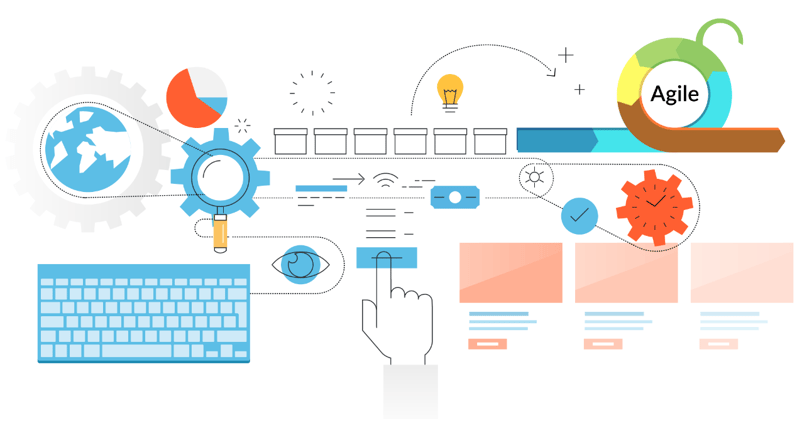The world of business is always changing. Customers are expecting continuous services from business applications. If any business application is down even for few minutes, it is not only a loss for the business, but also the customers lose trust in such companies.
In the above scenarios, the software development teams are under a lot of pressure to make sure that the business applications are frequently monitored and continuously tested. The software development teams including developers, testers and operations teams, must work together to achieve an agile work environment and fast-moving development speeds.
Generally, development teams work on the requirements and handover to testing. But due to scarcity of time, testing is not fully covered. Hence, continuous testing is recommended. In continuous testing, we use tools and processes such as automation to make testing effective and successful.
Why Agile Way Of Working Is Important?
In the traditional ways, software was released once in a year, or maybe twice in a year. In today’s world, software products are released once in few months, even weeks, sometimes even days and continuously even. Courtesy the demand of the business, software teams are expected to release tested software quickly/daily and as per customer’s requirements. This means that the software must be continuously integrated, tested and delivered on time.
Companies are changing the way development teams are organized and the ways in which the software release teams are integrated with the testing teams. To achieve continuous testing goals, companies must maintain agile testing teams.
Development + Operations = DevOps (architecture styles + tools + process + culture) > Code to production
Quality At Speed Is Achieved By
- Continuous Integration (CI) – driven by tools (eg. Jenkins)
- Continuous Delivery (CD) – driven by automated tools and teams (configuration management tools: Puppet, Ansible, Chef)
- Continuous Testing (CT) – driven by tools, teams, members and services
An Agile Software Environment Is Necessary For Continuous Testing
Continuous testing can be achieved with automation techniques and tools. Testing teams have less time to complete their tasks, and hence, automation is necessary to test things in the required time. Instead of maintaining large chunks of code and functions to be tested, the development process now makes available small chunks of code to be tested and integrated. This gives the teams the speed to deliver software quickly and make updates in an agile way.
Agile: Plan > Create > Verify > Stage > Release > Configure > Monitor

The Need For Continuous Testing
Continuous delivery requires continuous testing. Finding defects early in the life cycle reduces costs to the company. Test automation plays a critical role in enablement of continuous testing. End-to-end automation activities helps match the speed of DevOps and developers can also release features quickly. Continuous testing is the process of executing automated tests for speed and defect-free software delivery. You can obtain feedback on the business risks quickly.
Achieve Continuous Testing Through Maximum Automation
An agile development environment is necessary to maintain a continuous testing culture. Continuous testing is necessary to deliver defect-free software. Software automation tools and processes are important to achieve the required speed of testing. The teams must be well organized to efficiently coordinate the development, testing, configuration and delivery of software assets and applications.

The current testing practices need to adapt to new ways of thinking:
- Testing must be aligned with business risk
- Test execution must be optimized
- Automation must be incremented
- Release decisions must be aligned with business
- Exploratory testing must shift to core
- API layer testing must happen early
- Test data management must be automated
- Service virtualization must be adopted
Realizing Continuous Testing Goals In An Agile Environment
Continuous testing must be founded on DevOps, agile and continuous delivery. The stories and requirements must be tested by all stakeholders – product managers, developers, and testers. Pair programming and test-driven development (TDD) must be encouraged to make code changes quickly. Service layers must be tested as and when they are created. Code must be built in small pieces and released via configured branches into the main build. Software must be containerized and continuously tested by live users throughout the life cycle. All parts must be interconnected and enabled by continuous testing.
Conclusion
Continuous testing can be implemented only in an agile development environment. In my experience when projects have more manual testing requirements and testing time is less, the coverage of testing gets affected. We must reduce the manual effort and focus more on automation to satisfy continuous testing requirements. This can happen only if the teams are working in an agile way in collaboration with the developers and DevOps teams.
Innominds is a dedicated product incubator for technology industry clients seeking help with Design, Technology and Quality Engineering solutions across all stages of their product life cycle. We have deep expertise in Quality Engineering with extensive experience in setting up dedicated and secured Offshore Development / Test Centers with replicated client environments for technology companies and Enterprises, ensuring Quality @ Speed.
Interested! For any demos or POCs, please write to us at marketing@innominds.com and know more about our offerings.




